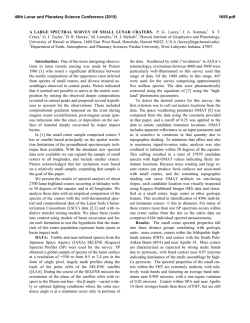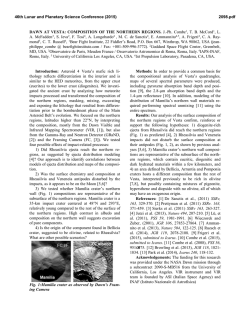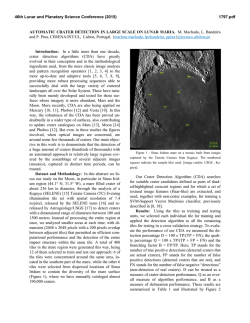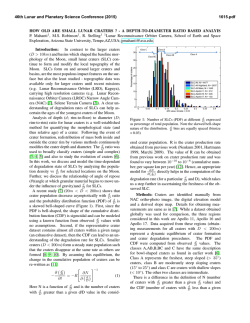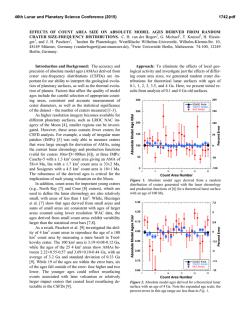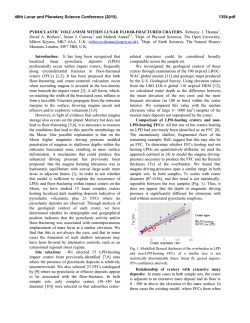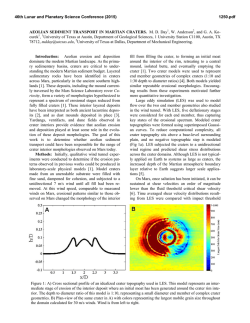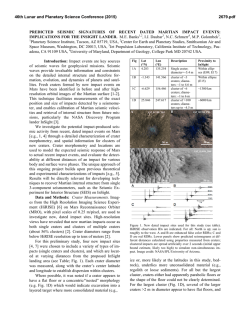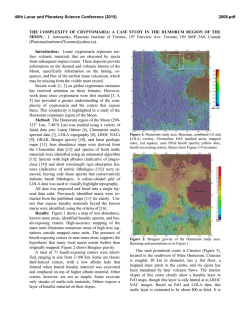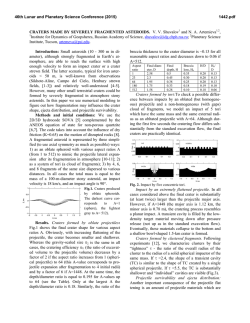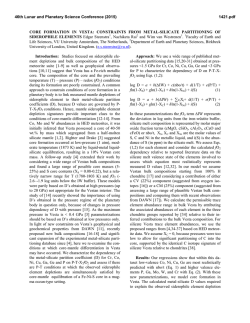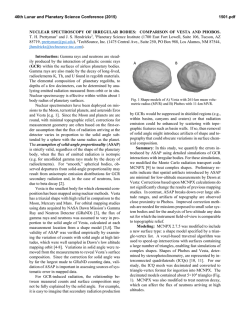
Morphologies of Fresh Craters, Lunar Analogs - USRA
46th Lunar and Planetary Science Conference (2015) 2571.pdf MORPHOLOGIES OF FRESH CRATERS, LUNAR ANALOGS, AND THE SIMPLE- COMPLEX TRANSITION ON VESTA. G. Y Kramer1, P. Schenk1, and the Dawn Team; 1Lunar and Planetary Institute, Houston, TX. Introduction: Dawn mapping [1] of Vesta has provided our first close look at impact crater formation processes on the previously unexplored largest asteroids/ dwarf planets. Mapping of the largest previously visited asteroids (e.g., Lutetia) revealed only simple craters [2], and Vesta is the first silicate–rich body examined that is significantly smaller than the Moon yet is expected to be large enough to have complex craters. Vesta is heavily cratered [3]. The morphology of craters of all classes and erosion states was examined by [4], but in this report we describe the shapes and morphologies of pristine craters on Vesta and the Moon. This serves three objectives: (1) examine the question of whether complex craters actually formed on Vesta and establish a reference shape of intact craters for determining the degree of erosion, mantling, and/or relaxation of older craters; and (2) determine the simple-tocomplex crater transition in relatively fresh, unmodified craters to compare with prediction and other terrestrial bodies (the simple-to-complex transition on Vesta is predicted to be ~60-70 km [5, 6]); (3) advance our understanding of the factors that control crater formation and morphology. We consider comparison to lunar craters of a similar size, and comparison to lunar craters of a scaled size (where size is scaled according to inverse gravity scaling [5]). Impact crater morphologies on Vesta are determined from the global Framing Camera (FC) mosaic of Vesta at 20 meter resolution (except north of 55°N latitude where resolution is 65 meters). Shapes are determined using topographic data mapped at 65 m resolution from FC stereo imaging [7]. Crater Morphology: While ancient craters as large as 250 km have been identified on Vesta [3,7], the global effects of ejecta produced from the two large impact basins at the south pole, Rheasilvia and Veneneia (D 505 and 395 km, respectively), have effectively mantled most impact craters formed prior to Rheasilvia with debris up to several kilometers [8]. Since the research objectives require focus on craters unmodified by erosion or mantling, our work is restricted to those craters formed after the basin. Rheasilvia itself is estimated at roughly 1 Gyr in age [3,7], which is relatively young, and as a result, large intact, unmantled post-basin complex craters are relatively few. The largest such crater, Marcia, is only 65 by 72 km in size (Fig. 1), approximately the predicted diameter of the simple-to-complex transition on Vesta. Simple Craters: Impact craters on Vesta smaller than ~30 km have a classic simple crater morphology, not radically dissimilar from lunar craters (Fig. 1). Such craters have a bowl or inverted-cone profile shape high- Fig. 1: Simple-complex transition diameters for planets and moons (from Pike, 1980; Schenk et al., 2004; White et al., 2013) showing possible inverse gravity-transition correlation. Note offset points for silicate and icy compositions. Two interpretations are possible: (a) transition diameters are only moderately correlated with surface gravity, and (b) transition diameters are inversely correlated with surface gravity. Fig. 2: Comparison of lunar and vestan craters. Vestan craters on right, lunar analogues on right. For each of the 3 vestan craters a lunar crater of similar scaled size and similar absolute size are shown. lighted by a sharply defined roughly circular rim scarp with outcrops of possible bedrock along the inner rimwall and lobate debris slides extending from the rim 46th Lunar and Planetary Science Conference (2015) down to the bottom of the crater. Simple craters have depth/diameters that may be ~15% deeper than lunar equivalents (Fig. 2). Rim heights may be 30% higher on Vesta compared to lunar craters, pending reevaluation of the lunar crater data (Fig. 3). Fig. 2: Depth/Diameter curve for fresh intact craters on Vesta. Closed dots are simple craters, open dots are transitional craters and crosses are older basins. Lunar curve in black is shown for comparison. Note that older and larger basins fit along an extrapolation of the fresh transitional crater population. Transitional Craters: Rheasilvia is the only well-preserved impact crater on Vesta larger than 30 km (Veneneia being obscured or obliterated by the later Rheasilvia), and exhibits a fully expressed complex crater morphology. Rheasilvia is broadly bowl-shaped and has a prominent modified-conical central uplift and isolated slump features along the inner rim crest [8]. Rheasilvia does not have a lunar analogue. Intact craters larger than ~30 km have unusual floor morphologies that are neither simple not complex, at least by lunar standards. These craters are broadly bowl-shapes with steep inner rimwalls and debris slides but most have a rounded but distinctly noncircular shape. They also have either broad flat floors or large arcuate to irregular mounds covering a broad crater floor (Fig. 1). Marcia is broadly flat floored but also has a small central mound or massif that may be a putative central peak, but otherwise classical conical central peaks are not developed or preserved in any Vesta craters other than Rheasilvia. All such craters are also significantly shallower than similar-sized simple craters (Fig. 3). Although classical central peaks and floor ter- 2571.pdf races are not well developed, these landforms are regarded as transition craters - transitional from simple to complex morphology. Similar landforms are observed in transitional craters on the Moon (e.g., Ryder, Dawes, Girodano Bruno). Accepting the transitional crater d/D curve (and the associated large basin d/D measurements) as the only preserved segment of the complex crater curve on Vesta, we can estimate the transition diameter Dtr for Vesta from the intersection of this with the well-defined simple crater d/D curve (Fig. 3). This intercept or inflection occurs at Dtr ≈ 28 km, roughly half that predicted from simple extrapolation of the measured Dtr of the Moon and other silicate planets (Fig. 2). Discussion: At face value, the new Dtr trend for silicate targets when Vesta is included is Dtr ≈ D-0.7, indicating a weaker but still significant dependence on complex crater formation on surface gravity (Fig 3). One interpretation of Figure 3 is that we are seeing the combined influence of gravity and strength on crater collapse and complex crater initiation. (The role of impact velocity remains indeterminate. It is also possible that even 60-km craters on Vesta formed in the strength rather than the gravity regime.) Thus the g-Dtr relationship may remain valid for all bodies but that strength is very important (as evidenced by the different ice and rock trends in Fig. 3) and that Vesta and the icy satellites of Saturn all have significantly weaker crustal strengths than their larger cousins; why is unclear. Two hypotheses are considered to explain the differences in crater morphologies observed on Vesta compared to the Moon: 1. The original transient cavity dimensions are better preserved on Vesta because of lower surface gravity relative to the Moon. In this case, the amount of rim slumping is reduced in Vestan craters, resulting in less diameter enlargement and less shallowing. There is less overburden stresses, rim failure, and the modification process is less substantial. This hypothesis is consistent with the relatively reduced amount of floor debris and flat floor deposits. 2. The lower g affects the rim uplift process differently on Vesta. An example would be an enhanced degree material injected into the subsurface (cf. [10]). This process could work in concert with Hypothesis 1. Acknowledgements: The author thanks the Dawn at Vesta Participating Scientist program. References: [1] Russell, C., et al., Science, 336, 684-687 (2012). [2] Vincent, J.-B., PSS, 66, 79-86 (2012). [3] Marchi, S., et al., PSS, 66, 87-95 (2012). [4] Vincent, J.-B., et al., LPSC 43rd, #1415 (2012). [5] Pike, R., Proc. 11th Fig. 3: Simple-complex transition diameters for planets and moons (from Pike, LPSC, 2159-2189 (1980). [6] Schenk, P., et al., in Jupiter, 1980; Schenk et al., 2004; White et al., 2013) showing possible inverse gravity- p. 427 (2004). [7] Jaumann, R., et al., Science, 336, 688transition correlation. Note offset points for silicate and icy compositions. Two 691 (2012). [8] Schenk, P., et al., Science, 336, 693-695 interpretations are possible: (a) transition diameters are only moderately corre- (2012). [9] White, O. et al., Icarus 223, 699-709 (2013). lated with surface gravity, and (b) transition diameters are inversely correlated [10] Sharpton, JGR, 119 (2014). with surface gravity.
© Copyright 2025

